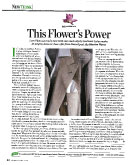This Flower’s Power
Departures | June 2011
Loro Piana sourced a rare cloth once used only by Southeast Asian monks. Its origins, however, have a far-from-blessed past.
By Marion Hume
Inle Lake, in southeast Burma, is a beautiful spot. Some 14 miles long and seven miles wide (it is hard to tell where the reeds end and the land begins), the lake is dotted with local fisherman balancing on the bows of their wooden skiffs. They live in thatched houses on stilts above the lake and grow vegetables on floating gardens tethered to the water bed with strips of bamboo. Through a camera, or just sitting back in a longboat and gazing at the scene, you would think this is paradise. It isn’t.
Burma (whose military regime arbitrarily renamed it Myanmar in 1989) is among the world’s poorest countries. Despite the release last fall of democracy fighter and Nobel Prize winner Aung San Suu Kyi, who was placed under house arrest for opposing the dictatorship, the country is still very much under the grip of an autocracy. Sanctions designed to deny the generals and their cronies foreign currency mean that almost nothing from Burma can be imported into the United States. And although European sanctions do not cover textiles, considerable pressure has been applied on mass-market manufacturers not to source from a country where cheap clothes come at high price when it comes to human rights.
So what on earth is Pier Luigi Loro Piana, of the luxury label known for peerlessly fine garments in cashmere, vicuna and silk, doing here? Why is this charming Italian, who is hardly unfamiliar with private jets and yachts, sitting barefoot on the floor of a Burmese thatched-roof house? He is watching a woman remove sappy filaments from the stems of the country’s wild lotus flowers that grow everywhere on the lake. He moves on to watch another woman spinning yarn on a contraption that would not look out of place in a museum. There are looms here – of the type rarely seen in the West since the 18th century – and women sit at them, their hands sending shuttles flying to and fro.
These are among the world’s last weavers of lotus flower fabric, a textile prized for its fineness, lightness and extraordinary ability to keep its wearer cool in even the warmest of climates. When Mr. Loro Piana, the Marco Polo of fashion, learned that lotus-flower cloth, which was once woven only for the ceremonial robes of monks, was still being made, he headed to the source. The company offered to buy all production, which is only about 55 yards a month, and paid the community of artisans in advance, then pledged more orders season after season-and in so doing has helped ensure that a unique tradition survives and that the craftsmen are now paid fairly. As a Loro Piana spokesperson explains: “The fibre is great and exclusive, yes, but people are being helped. The idea behind the project was not just to give fish, as they saying goes, but teach them how to fish.”
In a select clutch of Loro Piana stores-none in the United States, where imports are still prohibited- the cloth, which has a nubby, linen-like texture of raw silk, is now available. It is sold loose to be later tailored into sumptuous jackets (from $5,600); its fineness makes it less suitable for trousers. Pier Luigi is hoping the US government will grant lotus-flower cloth an exemption from sanctions. With Aung San Suu Kyi calling for careful, ethical engagement with Burma once again, reviving the magical cloth of monks, which has the desirable secular property of cooling one down on a warm day, might be a appropriate way to begin.


